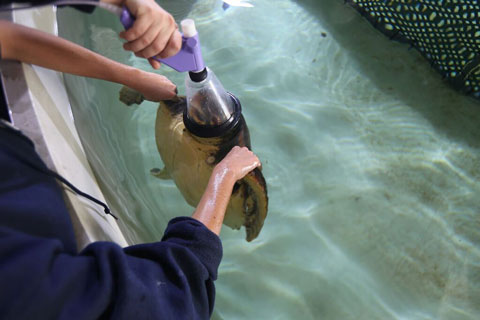ndd Medical’s EasyOne Spirometers Instrumental in Study and Treatment of Endangered Sea Turtles Caught in Fishing Nets
Mobile spirometry technology developed by NDD Medical Technologies, Inc. is being used to measure lung function in endangered sea turtles \| 3 Min read

Mobile ultrasound pulmonary function testing (PFT) technology and software developed by ndd Medical Technologies, Inc. is now being used to measure lung function in endangered sea turtles, with the goal of reducing deaths from decompression sickness — the often fatal condition that occurs after the turtles are accidentally caught in fishing nets and then, seemingly healthy, released.
The veterinary team, Drs. Daniel Garcia-Parraga and Jose Luis Crespo, at Oceanogràfic, Valencia have only recently discovered sea turtles’ susceptibility to decompression sickness.
“Fishermen catch the turtles, then throw them back because they look healthy, but they often die one, two or three days later,” explained Oceanogràfic-based veterinarian Jose Luis Crespo, one of the authors of a groundbreaking 2014 study proving for the first time that air-breathing marine vertebrates, specifically loggerhead turtles, can suffer from decompression sickness, also known as the bends.
At Oceanogràfic, scientists are studying sick turtles’ respiratory systems with ndd Medical’s spirometers, normally used to measure the volume of air entering and leaving the lungs of humans in order to diagnose conditions such as chronic obstructive pulmonary disease. The scientists have adapted the device so it can easily fit over turtles’ heads.
“The ndd EasyOne device is an amazing non-invasive tool for field biologists,” says Andreas Fahlman, PhD, a marine biologist studying the physiology of distressed loggerhead, leatherback and green turtles at Spain’s Oceanogràfic, Europe’s largest aquarium. “It’s ultrasonic so you don’t need to calibrate it. It’s small and portable so you can easily bring it onto a boat or beach. It’s a match made in heaven when it comes to the field-work we are doing.” Fahlman, the Director of Research at Oceanogràfic and head of the comparative physiology laboratory at Texas A&M University Corpus Christi, TX collaborates with colleagues in Valencia, and around the world.
They are hopeful that with a better understanding of the gas exchange process, they’ll be better able to save the turtles.
Oceanogràfic veterinarians are treating turtles brought in with the bends with hyperbaric oxygen therapy. Supplemental oxygen is pumped into the chamber, enabling the animals to exhale the nitrogen that has formed dangerous bubbles in their tissues and blood. This is the same treatment that humans with decompression illness — including deep sea divers— undergo.
The work of the team at Oceanogràfic has also led to worldwide protocol changes that encourage fisherman who inadvertently catch turtles in their nets to bring them in for treatment instead of throwing them back. Crespo said that studies estimate that about 300 sea turtles a year are caught in fishing nets in Valencia waters, although experts believe the numbers are actually two to three times that.
